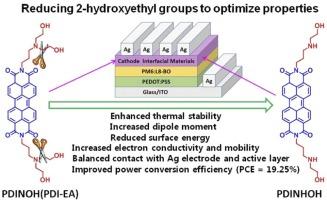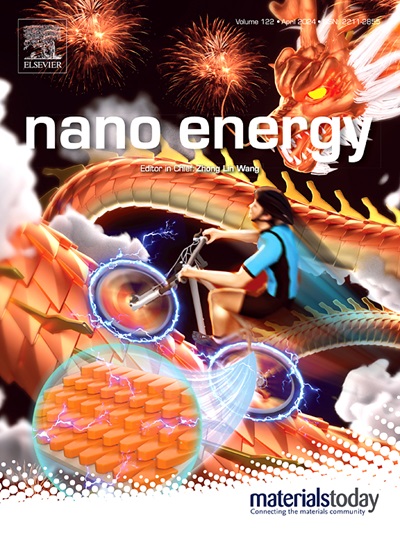Optimizing interface properties of perylene-diimide-based cathode interlayer material by reducing 2-hydroxyethyl groups to achieve organic solar cells with efficiency over 19 %
IF 16.8
1区 材料科学
Q1 CHEMISTRY, PHYSICAL
引用次数: 0
Abstract
Polar functional side group plays an important role in regulating interface properties of diimide-based cathode interlayer materials (CIMs). Herein, we designed and synthesized two perylenediimide (PDI)- and naphthodiimide (NDI)-based CIMs, PDINHOH and NDINHOH, through properly reducing the number of polar 2-hydroxyethyl groups to optimize interface properties. Two CIMs were easily obtained by readily available raw materials and one-step reaction, exhibiting low product cost and excellent solubility. Results demonstrate that these 2-hydroxyethyl amino functionalized CIMs not only remain many outstanding advantages of bis(2-hydroxyethyl) amino, including reduced work function of Ag electrode, obvious self-doping effect, well-matched molecular energy levels and good contact with metal electrode, but also can improve thermal stability and dipole moment, reduce surface energy, optimize the contact with active layer, and increase electron conductivity and mobility. Benefitting from these comprehensive characteristics, organic solar cells (OSCs) based on PM6:L8-BO with PDINHOH as the CIM achieved an outstanding PCE up to 19.25 %, which is obviously higher than that of the counterpart NDINHOH (18.60 %) and that with the commonly used CIMs of PFN-Br (17.37 %) and PDINN (18.09 %) as well as the bis(2-hydroxyethyl) amino functionalized analogue. Importantly, these CIMs show good universal application in different active layer systems, metal electrodes and device structures. Additionally, PDINHOH-modified devices exhibit excellent storage stability, thermal and photo stability. This finding suggests that the rational modification of the polar functional side chains of diimide-based CIMs is a simple and effective strategy to optimize interface properties, and thereby obtaining thickness-insensitive, high-performance and stable OSCs.

求助全文
约1分钟内获得全文
求助全文
来源期刊

Nano Energy
CHEMISTRY, PHYSICAL-NANOSCIENCE & NANOTECHNOLOGY
CiteScore
30.30
自引率
7.40%
发文量
1207
审稿时长
23 days
期刊介绍:
Nano Energy is a multidisciplinary, rapid-publication forum of original peer-reviewed contributions on the science and engineering of nanomaterials and nanodevices used in all forms of energy harvesting, conversion, storage, utilization and policy. Through its mixture of articles, reviews, communications, research news, and information on key developments, Nano Energy provides a comprehensive coverage of this exciting and dynamic field which joins nanoscience and nanotechnology with energy science. The journal is relevant to all those who are interested in nanomaterials solutions to the energy problem.
Nano Energy publishes original experimental and theoretical research on all aspects of energy-related research which utilizes nanomaterials and nanotechnology. Manuscripts of four types are considered: review articles which inform readers of the latest research and advances in energy science; rapid communications which feature exciting research breakthroughs in the field; full-length articles which report comprehensive research developments; and news and opinions which comment on topical issues or express views on the developments in related fields.
 求助内容:
求助内容: 应助结果提醒方式:
应助结果提醒方式:


